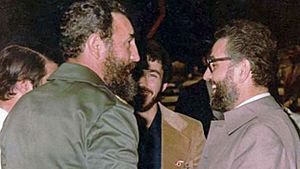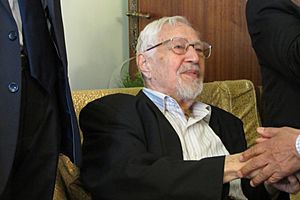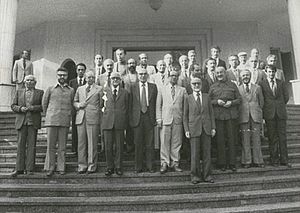Ebrahim Yazdi facts for kids
Quick facts for kids
Ebrahim Yazdi
|
|
|---|---|

Yazdi in 1979
|
|
| Minister of Foreign Affairs of Iran | |
| In office 12 April 1979 – 12 November 1979 |
|
| Prime Minister | Mehdi Bazargan |
| Preceded by | Karim Sanjabi |
| Succeeded by | Abolhassan Banisadr (acting) |
| Deputy Prime Minister of Iran for Revolutionary Affairs | |
| In office 13 February 1979 – 12 April 1979 |
|
| Prime Minister | Mehdi Bazargan |
| Succeeded by | Mostafa Chamran |
| Member of the Parliament of Iran | |
| In office 28 May 1980 – 28 May 1984 |
|
| Constituency | Tehran, Rey and Shemiranat |
| Majority | 1,128,304 (52.9%) |
| Personal details | |
| Born | 26 September 1931 Qazvin, Imperial State of Persia |
| Died | 27 August 2017 (aged 85) İzmir, Turkey |
| Citizenship |
|
| Nationality | Iranian |
| Political party |
|
| Relatives | Mohammad Tavasoli (brother-in-law) Mehdi Noorbakhsh (son-in-law) |
| Alma mater | University of Tehran Baylor College of Medicine |
Ebrahim Yazdi (Persian: ابراهیم یزدی; 26 September 1931 – 27 August 2017) was an Iranian politician, pharmacist, and diplomat. He served as a deputy prime minister and the foreign minister in Iran's first government after the 1979 revolution. He resigned in November 1979 because he disagreed with the Iran hostage crisis. From 1995 until his death in 2017, he led the Freedom Movement of Iran, a political group. Yazdi was also a trained cancer researcher.
Contents
Early Life and Education
Ebrahim Yazdi was born in Qazvin, Iran, on 26 September 1931. He studied pharmacy at the University of Tehran. He also earned a master's degree in philosophy from the same university.
After a military takeover in 1953, which removed the government of Mohammad Mosaddegh, Yazdi joined a secret group called the National Resistance Movement of Iran. This group worked against the Shah (king) of Iran, Mohammad Reza Pahlavi. In 1961, Yazdi moved to the United States to continue his studies. There, he kept working against the Shah's rule.
In 1961, he helped start the Freedom Movement of Iran, Abroad. This group included other important figures like Mostafa Chamran and Ali Shariati. In 1963, Yazdi and others went to Egypt to create an organization against the Shah, called SAMA. Later, in 1966, Yazdi moved SAMA's main office to Beirut. In 1967, he studied at Baylor College of Medicine in Houston, USA, where he earned a PhD in biochemistry.
Because of his political activities, an Iranian military court sentenced Yazdi to ten years in prison in 1975. He was not in Iran at the time, so he could not return. He stayed in the United States until July 1977. He became a US citizen in 1971. In 1978, when Ayatollah Khomeini moved to a suburb of Paris, France, Yazdi joined him. He became an important advisor and spokesperson for Khomeini.
Political Career and Activities
Before the revolution, Yazdi worked as a research assistant and instructor at Baylor College of Medicine in Houston. He also worked at a hospital for veterans. From 1961 to 1977, he helped create the Muslim Students Association in the United States. Later, he became a spokesperson for Ayatollah Khomeini, who was living in Paris.
In 1978, Yazdi joined Ayatollah Khomeini in Paris and became one of his trusted advisors. He helped translate Khomeini's messages into English for the press. After the Iranian Revolution in 1979, Yazdi became the deputy prime minister and foreign minister in the first government, led by Mehdi Bazargan. He served until November 1979. Yazdi suggested celebrating 'Jerusalem Day', which Khomeini supported in August 1979. Yazdi's American citizenship was taken away in 1979. In May 1980, Khomeini appointed him to lead the Kayhan newspaper.
Soon after the revolution, in February 1979, some foreign embassies in Tehran were taken over by groups. Yazdi, as a member of the Revolutionary Council, helped solve these situations. For example, when the US embassy was taken over, he helped free the staff, including the US ambassador.
However, on 4 November 1979, the US embassy was taken over again. This time, a group called “Students Following the Line of the Imam” was responsible. Yazdi was asked to help again. He got permission from Khomeini to remove the occupiers. But then, Khomeini changed his mind and publicly supported the takeover on state television. Because of this, the entire government, including Yazdi and Prime Minister Mehdi Bazargan, resigned the next day. They believed the embassy takeover was "against Iran's national interest."
The embassy takeover was partly due to disagreements among the revolutionary leaders. Yazdi and Bazargan were on one side, and more radical religious leaders were on the other. The students who took over the embassy later said one of their goals was to force Yazdi and Bazargan to resign.
One major disagreement was about the Revolutionary Courts. Yazdi and Bazargan wanted to offer forgiveness to people who had worked for the Shah, as long as they stopped working against the revolution. They spoke out against the secret trials and quick executions carried out by these courts. They wanted fair and open trials. However, the radical religious leaders believed that quick trials and executions were needed to protect the revolution.
After leaving his government role, Yazdi and others from the Freedom Movement of Iran ran for parliament. Yazdi, Bazargan, and four other members of the Freedom Movement were elected. They served in the parliament from 1980 to 1984.
When Iraq invaded Iran in September 1980, Yazdi supported Iran's efforts to defend itself. But after Iran won a major victory in Khorramshahr in 1982, Yazdi believed the war should end. The war continued for six more years. During this time, Yazdi and the Freedom Movement wrote several open letters to Ayatollah Khomeini, asking him to stop the war. Because of these actions, Yazdi's home in Tehran was attacked with firebombs in 1985. Several members of the Freedom Movement were also arrested.

In later elections for president, parliament, and city councils, Yazdi and other Freedom Movement members tried to run. However, they were often stopped from running by the Guardian Council. This was because they disagreed with the government's policies.
In December 1997, Yazdi was arrested and held in Evin prison in Tehran. He was later released but was not allowed to leave the country for many years. He was often called in for questioning by the revolutionary council. As of 2008, he was still accused of "trying to change religious rule into democratic rule."
After Bazargan died in 1995, Yazdi became the leader of the Freedom Movement of Iran. In 2011, under pressure, Yazdi offered to resign as leader. However, the leadership council did not accept his resignation, and he continued to lead the movement.
Electoral History
| Year | Election | Votes | % | Rank | Notes |
|---|---|---|---|---|---|
| 1980 | Parliament | 1,128,304 | 52.9 | 15th | Won |
| 1989 | President | N/A | Disqualified | ||
| 1993 | President | Disqualified | |||
| 1997 | President | Disqualified | |||
| 2005 | President | Disqualified | |||
Later Years and Death

Yazdi was arrested in December 1997 for "insulting religious beliefs" and was released on bail. In June 2009, during protests about the Iranian election, Yazdi was arrested while in a Tehran hospital. He was released a few days later for a medical procedure. In December 2009, he was arrested again after more protests.
In October 2010, Yazdi and others were arrested in Isfahan for taking part in an "illegal Friday prayer." Most others were freed quickly. Ebrahim Yazdi remained in "temporary custody" until March 2011. He was released in April 2011.
On 27 August 2017, Ebrahim Yazdi passed away from pancreatic cancer. He was 85 years old and was receiving treatment in İzmir, Turkey. His body was brought back to Iran and buried in Behesht-e Zahra.
| Political offices | ||
|---|---|---|
| Preceded by Karim Sanjabi |
Foreign minister of Iran 1979 |
Succeeded by Sadegh Ghotbzadeh |
| Party political offices | ||
| Preceded by Mehdi Bazargan |
Secretary-General of Freedom Movement of Iran 1995–2017 |
Succeeded by Mohammad Tavasoli |
| Preceded by Abbas Amir-Entezam |
Head of Political Bureau of Freedom Movement of Iran 1979–1995 |
|
| Media offices | ||
| Preceded by Mostafa Mesbahzadeh |
Head of Kayhan Institute 1979–1981 |
Succeeded by Mohammad Khatami |


